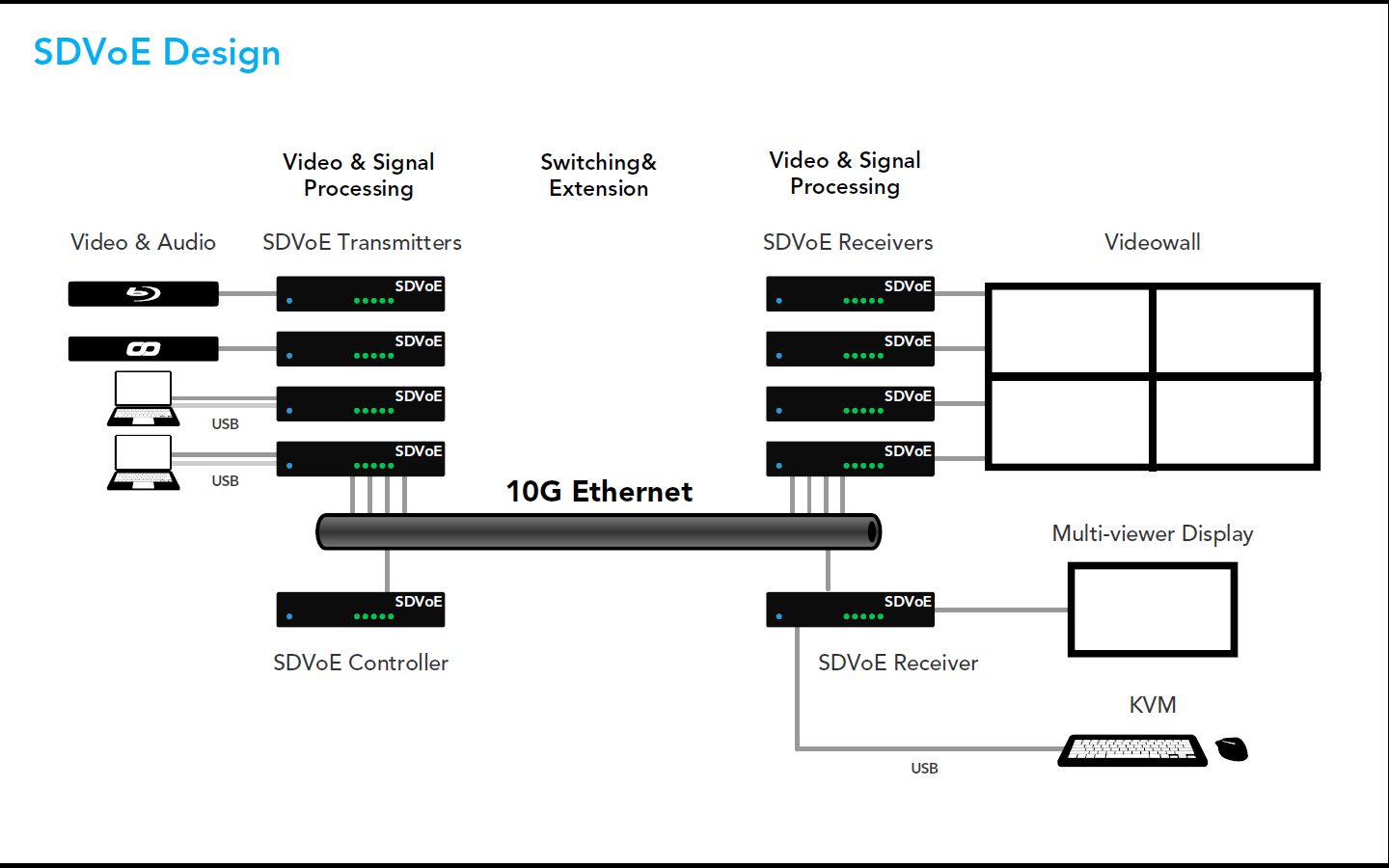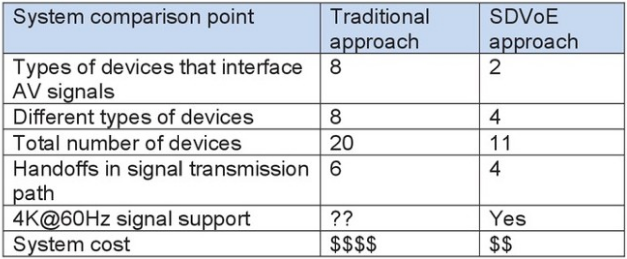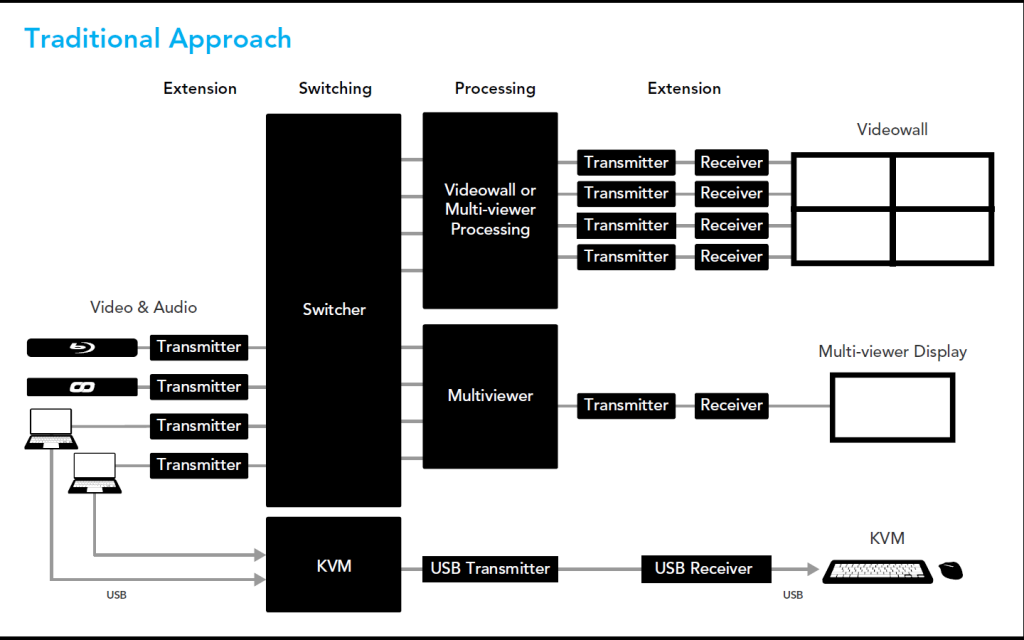“It should be simple, flexible and affordable.”
That’s a common refrain heard in our industry when spec’ing an AV system. The end user demands a simple, reliable and intuitive experience. The technicians want a system that is easy to set up and manage. Administrators want a reliable solution that has the flexibility, power and capacity to do more now, and to expand into the future. And those signing the PO want it to fall within budget.
System designers work hard to meet those demands. They continually adapt to migrating customer desires, redesigning systems as budgets change. Or, in situations that are more drastic, they throw out the design completely and start over. What’s more, the introduction of new content or display formats and resolutions has produced many different products, which have served to muddy the proverbial swamp with a mish-mash of technical platforms and product architectures. Certain approaches might use a monolithic, single-product design suitable for a mid-sized system, but that has to be thrown out when it requires scaling down. Conversely, systems that need to scale up to support a growing organization might require a completely different approach.
All of this is to say that every application requires a different design, using different product platforms. On top of that, each advancement in the evolution of AV source formats and display resolutions has produced new requirements to build bigger, better systems, continually challenging system designers.
It’s a mess out there in the world of AV systems, and it’s time to clean house!
Today’s Limitations
Traditional systems based on proprietary circuit-based switching—the most common element in AV system design—has inherent bandwidth and scalability limits. Sometimes, AV system designs use video processors, or add them to the switching platform, to fulfill multi-image features that are more advanced. Regardless, each time AV source formats or displays advance—or the system is expanded to accommodate growth—the inherent scalability or bandwidth limits send them to the trash heap to be replaced with all-new, larger systems.

Sure, some tightly integrated products that combine many functions into tightly defined solutions have emerged that can be affordable, but they are certainly restricted in terms of scalability and flexibility.
This environment does not bode well for operations and organizations that need to adapt and expand to, and learn how to accommodate, increasingly common design requirements like 4K resolution, KVM support, multi-view processing or multi-screen videowalls.
Change Is Here
Fortunately, we’re on the cusp of a monumental change in AV system design. With the introduction of the Software Defined Video over Ethernet (SDVoE) Alliance, designers can transform their approach by moving toward a robust, powerful and open AV-over-IP platform. SDVoE-based solutions support the most common signal interfacing and processing requirements, while also exploiting the bandwidth, speed and scalability for signal distribution using IP networks. The SDVoE platform lets designers flatten their designs by using fewer devices to extend further, scale up faster and accomplish more than traditional matrix-switching approaches.
10G Is Foundational
SDVoE exploits stock, standard IEEE 10G Ethernet hardware. It’s the ideal platform to usher in AV-over-IP systems.
First up, 10G Ethernet has enough bandwidth to transport lossless and uncompressed AV signals, eliminating any concerns about artifacts. SDVoE over 10G Ethernet operates with zero-frame latency, eliminating experiences that impact control, interactivity and audio-processing requirements. Unlike compressed solutions, which can produce latency and artifacts on a 4K signal operating from 1G networks, it provides uncompromised quality and performance.

Extension, switching and scalability are also key factors contributing to why Ethernet networking is ideal. Using affordable, off-the-shelf 10G components, switching systems can be scaled to any size, and signals can be extended up to 18 miles using fiberoptic cable.
Although we might not know exactly how things will evolve, it’s inevitable that bandwidth requirements will increase. 10G Ethernet supports networks with the scale and bandwidth to support virtually any application that we’re faced with today. Ethernet, as a platform, can be built up with more bandwidth and scalability, exploiting products based on IEEE Ethernet standards as needs grow.
SDVoE: A Platform Built For 10G
SDVoE works together with 10G Ethernet to enable some pretty impressive functionality and performance features that leapfrog standard system design. Among them are the following:
- Broad support for AV signal and control, including common signal processing functions like embedding and de-embedding.
- Efficient system-wide EDID and HDCP 2.2 management, eliminating the last-minute system “gotchas” that irritate everyone.
- Flexible control allowing external or internally based interfaces, including USB connectivity for interactive KVM control over sources.
- The ability to present multiple sources on one screen, as well as enabling large, multi-screen videowall displays.
- Affordable solutions for hard-to-solve, unfulfilled problems with existing, mature video-processing and streaming products. These include:
- zero-frame latency, artifact-free signal
- signal synchronization across displays
- Interoperability between different manufacturers’ products, allowing different classes of product to emerge to solve a broader set of application requirements, thanks to 802.3 Ethernet and an alliance-based SDVoE standard.
Seeing Is Believing
For SDVoE to be broadly adopted, it must truly offer an improvement over the old way of doing things. It has to be “simple, flexible and affordable.”
Figure 1 and Figure 2 will allow you to compare a traditional, matrix-switch-based design with an SDVoE system. Both systems are designed to meet the same requirements: switching of multiple inputs, extension, a 2×2 videowall, one multi-view display and KVM control over sources.
The SDVoE system design is very flat and streamlined, requiring half the number of devices as a traditional approach does. The dramatic simplification of system design is one of the major advantages of SDVoE (see Figure 3). Not only do SDVoE systems employ fewer devices, but, in addition, because they use off-the-shelf 10G Ethernet components, they frequently result in lower-cost designs, especially as system requirements scale up in size. Every project is different, but a similar story appears when different applications are examined.
When you add the performance advantages of the SDVoE system as compared to traditional matrix-switching approaches, it’s clear that a software-defined Ethernet architecture is the platform to take AV systems beyond current capabilities and into the future.
